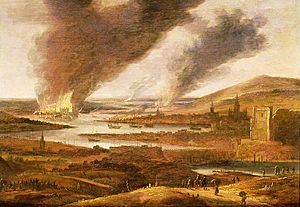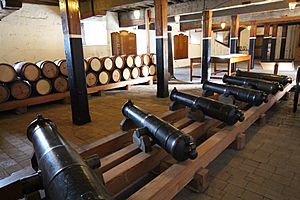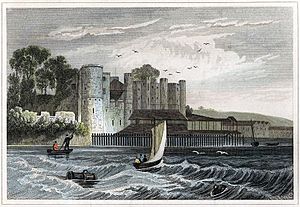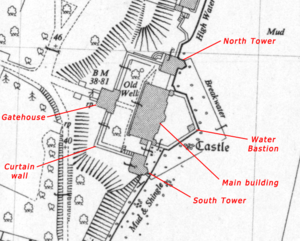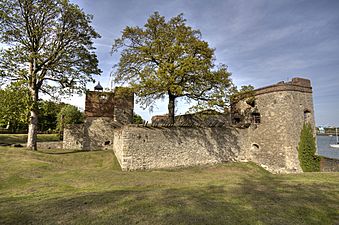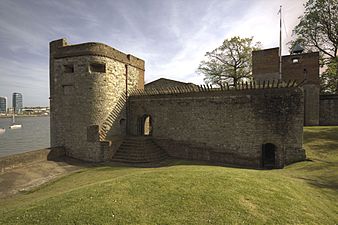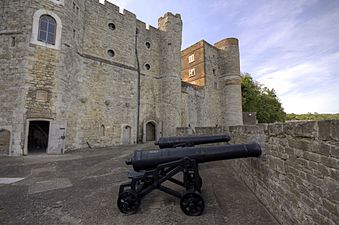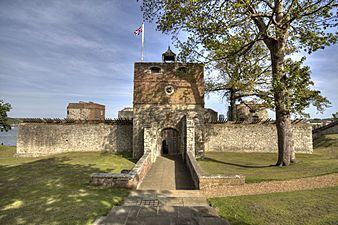Upnor Castle facts for kids
Quick facts for kids Upnor Castle |
|
|---|---|
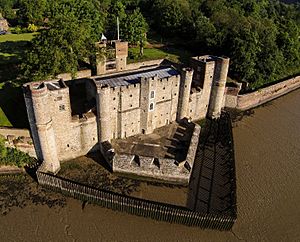
Upnor Castle on the River Medway
|
|
| Location | Upnor |
| OS grid reference | TQ7585670574 |
| Area | Kent |
| Built | 1559–67 |
| Built for | Royal Navy |
| Architect | Sir Richard Lee |
| Owner | English Heritage |
| Official name: Artillery castle at Upnor | |
| Designated | 28 January 1960 |
| Reference no. | 1012980 |
|
Listed Building – Grade I
|
|
| Official name: Upnor Castle | |
| Designated | 14 November 1986 |
| Reference no. | 1204365 |
| Lua error in Module:Location_map at line 420: attempt to index field 'wikibase' (a nil value). | |
Upnor Castle is an old fort built by Queen Elizabeth I. It stands on the west bank of the River Medway in Kent, England. The castle is in the village of Upnor, right across from the Chatham Dockyard. This dockyard was once a very important place for the Royal Navy.
The main job of Upnor Castle was to protect the dockyard and the navy ships. These ships would anchor safely in the Medway River. The castle was built between 1559 and 1567. This was a time when England had problems with Spain and other countries in Europe.
The castle has a two-story main building. It is protected by a strong outer wall and towers. A special triangular platform for guns sticks out into the river. About 80 soldiers lived there, and it had around 20 cannons.
Even though it was important, the castle and other defenses were not well looked after in the 1600s. In June 1667, the Dutch Republic launched a surprise attack. The Dutch fleet broke through the defenses. They captured two warships and burned others at Chatham. This was one of the worst defeats for the Royal Navy.
Upnor Castle did better than other forts during the attack. Its guns, and those from nearby spots, forced the Dutch to leave after a few days. This stopped them from burning the dockyard itself.
The attack showed that the Medway defenses were weak. After this, Upnor Castle was no longer used as a main fort. New, stronger forts were built further down the river. Upnor Castle then became a place to store ammunition for the navy. It held lots of gunpowder, bullets, and cannons. It was used by the military until 1945. Today, the castle is open to visitors and is looked after by English Heritage.
Contents
History of Upnor Castle
Why the Castle Was Built
The River Medway is a big river that flows into the River Thames. The part of the Medway near Rochester was a great place for large ships to anchor. The water was calm, and the hills around it offered protection from strong winds. Ships could anchor safely and even be repaired there.
By the time Queen Elizabeth I became queen in 1558, most of the Royal Navy's ships used this part of the Medway. It was known as Chatham and Gillingham Reaches.
The Thames River had defenses since the time of King Henry VIII. But the Medway had no strong forts to protect its ships. There were two old castles nearby, Rochester Castle and Queenborough Castle. But these were for defending land, not the river. So, there was a big need for new defenses to keep the navy's ships and buildings safe.
Building the Castle
Queen Elizabeth and her advisors ordered Upnor Castle to be built in 1559. A spot was chosen across from St Mary's Creek in Chatham. The land was bought for £25.
Sir Richard Lee, a military engineer, designed the new fort. But he was busy with other projects. So, his deputy, Humphrey Locke, oversaw the building. Richard Watts, a former mayor of Rochester, managed the daily work and money.
The castle looked different when it was first built. The arrow-shaped Water Bastion (the part facing the river) and the main building were part of the first design. Towers were also at each end of the river side. The gatehouse and moat were added later. Stones from old, broken buildings were used to build the castle. The main part was finished by 1564. The whole project cost £4,349.
Making the Castle Stronger
In the late 1500s, England and Spain had growing problems. Spain was strong and could attack southern England. New forts were built along the Medway. A big chain was even stretched across the river below Upnor Castle to block ships.
The castle did not have enough soldiers at first. Lord High Admiral Charles Howard, 1st Earl of Nottingham said this needed to change. By 1596, eighty men were stationed there. Each was paid eight pence a day.
Fears of a Spanish attack continued. So, the castle's defenses were made stronger between 1599 and 1601. A wooden fence was put in front of the Water Bastion. This was to stop anyone from landing there. A deep and wide ditch was dug around the castle. Towers were built to protect the bastion. The bastion itself was made taller, and a high wall was added. A gatehouse and a drawbridge were also built to protect the land side of the castle.
In 1603, a survey showed Upnor Castle had 20 guns. Another 11 guns were in two smaller forts nearby. These smaller forts were called Bay and Warham Sconces. The castle's guns included different types like culverins and demi-culverins. Even 34 longbows were part of the castle's weapons. This shows that archery was still useful back then.
By this time, parts of the castle were falling apart. The drawbridge was broken, and the gun platforms needed fixing. A new wall had to be built on the land side. The foundations of Warham Sconce were washed away, and both smaller forts became ruins.
In 1606, King James, his wife Anne of Denmark, her brother Christian IV of Denmark, and Prince Henry visited Upnor Castle. They had dinner on a ship called the Elizabeth Jonas.
During the English Civil War in 1642, Upnor Castle was taken by the Parliamentary forces without a fight. It was used to hold Royalist officers. In 1648, Royalists tried to take back control in Kent. But they were defeated, and the castle went back to Parliament. The commander, Sir Thomas Fairfax, ordered more repairs. The gatehouse was made taller, and the north and south towers were built up.
The Dutch Attack on the Medway
The castle only saw real fighting once. This was during the Dutch Raid on the Medway in June 1667. This was part of the Second Anglo-Dutch War. The Dutch, led by Lieutenant-Admiral Michiel de Ruyter, attacked and captured the town of Sheerness. They then sailed up the Medway to Chatham.
They got past the chain that was supposed to block the river. They sailed past the castle and took away two English warships. They also burned other ships. The Dutch stayed in the Medway overnight. The Duke of Albemarle quickly built a new gun battery next to Upnor Castle.
The castle's guns, the soldiers' muskets, and the new battery all fired at the Dutch ships. The Dutch tried again to sail past Upnor to Chatham. They burned some more ships but could not go further. They had to leave. This attack was called "the worst naval defeat England has ever sustained."
People at the time thought the castle and its soldiers did well. The London Gazette newspaper said the Dutch were "warmly entertained" by the castle's commander. They said the Dutch ships were damaged, and many of their men were killed. But Samuel Pepys, a navy official, wrote that the castle's soldiers did not have enough supplies. He said they fired their guns until they had almost no cannons left.
Becoming a Storage Place
The Dutch attack made the government decide to keep Upnor Castle strong. But the raid also meant the castle was no longer needed as a main fort. New, stronger forts were built further down the Medway. These new forts were meant to stop enemies from reaching Chatham.
So, in 1668, Upnor Castle was turned into a "Place of Stores and Magazines". This meant it would supply ammunition to navy warships. Guns, gun carriages, cannonballs, and gunpowder were stored in the main building. The building had to be made taller, and its floors were made stronger to hold the heavy weight. By 1691, it was England's most important storage place for ammunition. It held more than the Tower of London.
In 1811, a new storage building was built downstream from the castle. Upnor Castle stopped being used for storage after 1827. It became a workshop for filling explosive shells with gunpowder. More storage space was needed. So, six old ships, called hulks, were tied up next to the castle. They were used as floating storage places.
Later, more large storage buildings were built inland at Chattenden. These were connected to Upnor by a small railway. In 1891, the navy took full control of the castle and its storage area.
After the First World War, Upnor became a Royal Naval Armaments Depot. This was a place for testing firearms and explosives.
The castle stayed under military control. But it started to become more like a museum in the 1920s. During the Second World War, the castle was still used by the military. It was damaged by two enemy bombs in 1941. The bombing caused plaster to fall off the walls. Underneath, old drawings and writing were found, including a picture of a ship from around 1700.
Upnor Castle Today
After the war ended in 1945, the navy allowed Upnor Castle to be a museum. It was opened to the public. The castle was repaired and made better. In 1960, it was named an Ancient Monument. Today, English Heritage manages it. It is still owned by the Crown.
What Upnor Castle Looks Like
Upnor Castle is built from stone, bricks, and wood. Its main building is a two-story rectangle. It measures about 41 meters (135 feet) long and 21 meters (69 feet) wide. This building is called the Magazine today. It has changed a lot since it was first built. It used to have some rooms for soldiers. When it became a storage place in 1668, many changes were made. The second story was made longer to cover the old gun platforms on the roof. This gave more space inside for storage. The ground floor was divided into three parts. It had a wood floor and copper doors to prevent sparks. More items were stored on the first floor. A windlass (a type of winch) was used to lift things from the river.
A round staircase inside the building leads to the castle's main gun platform. This is a low, triangular structure that sticks out into the river. The castle's biggest guns were placed here in the open air. Today, you can still see six guns from the mid-1800s. This platform has nine openings for guns. Six face downstream, and three face upstream. Its rounded wall was designed to bounce off enemy cannonballs. A wooden fence also protected the water bastion. The fence you see today is a new version of the old one.
Two towers stand near the river, a short distance from the main building. They were first two-story buildings with open backs. They had gun platforms on their first floors. These guns could fire along the ditch around the castle. Later, they were changed to be living spaces. Their backs were closed with bricks, and they were made taller with a third story. You can still see where the old gun openings were. The South Tower was said to be for the castle's governor. But governors often did not want to live there because it was not very comfortable.
These two towers are connected to the main building by a wall with battlements. More cannons were placed in openings in this wall.
The main castle buildings are on the east side of a rectangular courtyard. Inside the courtyard are two large Turkey oaks. People say these trees grew from acorns brought from Crimea after the Crimean War. A stone wall, topped with brick, surrounds the courtyard. It is about 1 meter (3 feet) thick and 4 meters (13 feet) high.
You enter the courtyard through a four-story gatehouse on the north-western side. It has gun openings for extra defense. It was largely rebuilt in the 1650s after a fire. You can still see burnt stones on the first-floor walls from that fire. A central archway leads into a passage to the courtyard. Above the archway is a clock from the late 1700s. A wooden bell tower was added in the early 1800s. A modern flagpole is on top of the building.
A dry ditch surrounds the outer wall. It was once nearly 10 meters (33 feet) wide and 5.5 meters (18 feet) deep. But it has been partly filled in since then. Visitors used to cross a drawbridge to reach the gatehouse, but it is no longer there. A second entrance, called a sally port, is in the north wall. Inside the outer wall, you can still see the brick foundations of old buildings. These were storage sheds built in the 1600s for the soldiers.
Other Buildings Nearby
To the west of the castle is Upnor Castle House. It was built in the mid-1600s for the Storekeeper, the person in charge of the ammunition. It was made bigger in the 1700s and is now a private home.
A short distance south-west of the castle is a barracks building. It was built soon after 1718. This building replaced the old soldier rooms inside the castle when it became a storage place. It looks much the same today as it did 300 years ago. It is a rare example of an 18th-century barracks in England.
Other buildings that were part of the castle's storage area are still in the area. The oldest is a gunpowder magazine from 1857. Some other storage buildings were built further north. The military used this area until 2014.
See also
 In Spanish: Castillo de Upnor para niños
In Spanish: Castillo de Upnor para niños


